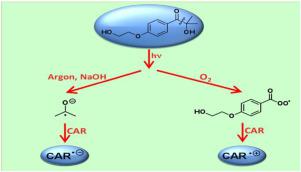Journal of Photochemistry and Photobiology B: Biology ( IF 5.4 ) Pub Date : 2020-09-10 , DOI: 10.1016/j.jphotobiol.2020.112023 Ali El-Agamey , Thor B. Melø , Maha A. El-Hagrasy , Vassilia Partali , Shunichi Fukuzumi

|
Laser excitation of a single precursor, namely 2-hydroxy-4′-(2-hydroxyethoxy)-2-methylpropiophenone (HHEMP), has been used for generating the radical cations and radical anions of various carotenoids in methanol. In the presence of oxygen, laser excitation of HHEMP undergoes an efficient α-cleavage reaction (Norrish type I) to form acyl radicals, which react with O2, in a nearly diffusion-controlled reaction, to form their corresponding strong oxidizing acylperoxyl radicals (RO2•) (E = ~1.1 V (v SHE)), which are capable of oxidizing almost all carotenoids. Under argon-saturated conditions and in the presence of strong base (0.01 M NaOH or tetrabutylammonium hydroxide (TBAOH)), the initially formed 2-hydroxy-2-propyl radical (ACH•), generated after LFP of HHEMP, is deprotonated to form the strong reducing acetone ketyl radical (AC•-) (E {acetone/ AC•-} = −2.1 V (v SHE)), which is capable of reducing all carbonyl-containing carotenoids. To validate this new proposed approach, retinal and β-apo-8′-carotenal (APO), with known spectroscopic data, were investigated in methanol, acetonitrile and tetrahydrofuran (THF). In addition, the radical ions of newly investigated carotenoids, namely 4-oxo-β-apo-15′-carotenoic acid (4-oxo-15′), crocetindial, 4-oxo-β-apo-10′-carotenoic acid ethyl ester (4-oxo-10′) and 4-oxo-β-apo-8′-carotenoic acid ethyl ester (4-oxo-8′) have been reported. Moreover, the scope of this approach has been extended to investigate the radical ions of chlorophyll b.
中文翻译:

类胡萝卜素自由基离子:激光闪光光解研究
单个前体即2-羟基-4'-(2-羟基乙氧基)-2-甲基苯乙酮(HHEMP)的激光激发已用于在甲醇中生成各种类胡萝卜素的自由基阳离子和自由基阴离子。在有氧的情况下,HHEMP的激光激发会发生有效的α裂解反应(Norrish I型),形成酰基自由基,然后在几乎扩散受控的反应中与O 2反应,形成相应的强氧化酰基过氧自由基( RO 2 •)(E =〜1.1 V(vSHE)),能够氧化几乎所有的类胡萝卜素。在氩气饱和的条件下,在强碱(0.01 M NaOH或四丁基氢氧化铵(TBAOH))存在下,HHEMP LFP后生成的最初形成的2-羟基-2-丙基自由基(ACH •)被去质子化以形成强还原丙酮酮基(AC •-)(E {丙酮/ AC •- } = −2.1 V(vSHE)),能够还原所有含羰基的类胡萝卜素。为了验证这种新方法,在甲醇,乙腈和四氢呋喃(THF)中研究了具有已知光谱数据的视网膜和β-apo-8'-胡萝卜素(APO)。此外,新研究的类胡萝卜素的自由基离子,即4-氧代-β-apo-15'-胡萝卜酸(4-氧代-15'),crocetindial,4-氧代-β-apo-10'-胡萝卜酸乙酯已经报道了其酯(4-oxo-10')和4-oxo-β-apo-8'-胡萝卜酸乙酯(4-oxo-8')。此外,该方法的范围已扩展到研究叶绿素b的自由基离子。



























 京公网安备 11010802027423号
京公网安备 11010802027423号